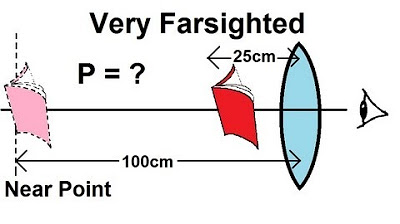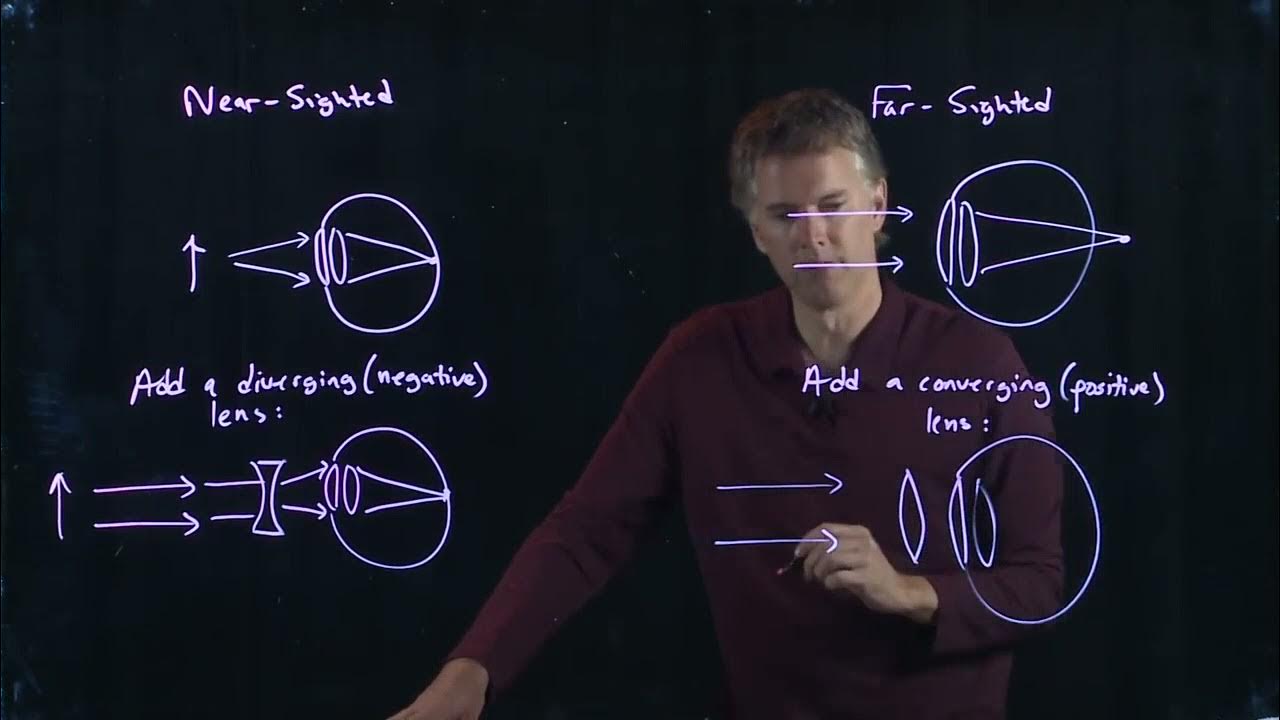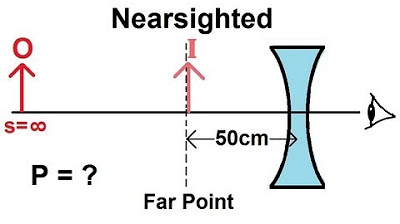Physics - Optics: Vision Correction (1 of 5) Introduction
TLDRThis online lecture delves into vision correction, explaining the common conditions of myopia (nearsightedness) and hyperopia (farsightedness). It describes how the eye's lens and muscles adjust focus for objects at varying distances. Nearsighted individuals require diverging lenses to push the focal point back onto the retina for clear distant vision, while farsighted individuals need converging lenses to pull the focal point forward for clear close-up vision. The lecture promises practical demonstrations in upcoming videos to help viewers determine the lens type best suited for their vision needs.
Takeaways
- 👀 Vision correction is necessary for individuals who are either nearsighted (myopia) or farsighted (hyperopia) to help them see clearly at different distances.
- 🔍 Nearsightedness allows for clear vision of nearby objects but results in a blurry view of distant objects because the focal point forms in front of the retina.
- 🌟 Farsightedness enables clear vision of distant objects but causes nearby objects to appear out of focus as the focal point forms behind the retina.
- 📈 Approximately half of the population experiences nearsightedness and requires corrective lenses, such as eyeglasses or contact lenses, to improve vision.
- 🔄 The eye's lens and muscles work together to adjust the focal point based on the distance of the viewed object, simulating an 'infinity' focus for distant objects.
- 🔍🔄 For distant vision, the eye muscles stretch the lens to move the focal point backward, which is necessary for forming a clear image on the retina.
- 🔍🔄🔄 Relaxing the eye muscles causes the lens to bulge naturally, which is beneficial for near vision as it brings the focal point closer, allowing for a clear image of close objects.
- 🤓 Nearsighted individuals cannot adjust the focal point far enough back without corrective lenses, which are diverging lenses that help to push the focal point back onto the retina.
- 👓 Farsighted individuals have a lens and eyeball shape that allows the focal point to fall on the retina for distant vision, but they require additional help for near vision due to the lens not bulging enough on its own.
- 👓🔄 Farsighted people benefit from converging lenses, such as reading glasses, which move the focal point to the left, ensuring the image falls on the retina for clear close-up vision.
- 📚 The script promises practical demonstrations in upcoming videos to help viewers determine the type of lens needed for clear vision, based on whether they are nearsighted or farsighted.
Q & A
What is the medical term for being able to see things clearly only when they are close by?
-The medical term for being able to see things clearly only when they are close by is myopia, also known as nearsightedness.
What condition is characterized by the ability to see distant objects clearly but difficulty focusing on nearby objects?
-Hyperopia, or farsightedness, is the condition where a person can see distant objects clearly but has difficulty focusing on nearby objects.
How does the eye naturally adjust to see objects at different distances?
-The eye naturally adjusts by using the ciliary muscles to change the shape of the lens, which alters the focal point to accommodate objects at varying distances.
Why do nearsighted individuals need corrective lenses to see distant objects clearly?
-Nearsighted individuals need corrective lenses because their eyes' focal point falls in front of the retina when trying to focus on distant objects, causing the image to appear blurry.
What type of lens is used to correct nearsightedness?
-A diverging lens, or concave lens, is used to correct nearsightedness by causing the focal point to fall further back, allowing the image to form clearly on the retina.
How does the eye's natural lens behave when a farsighted person tries to see nearby objects?
-When a farsighted person tries to see nearby objects, the ciliary muscles relax, causing the lens to bulge more, which ideally should bring the focal point closer to allow for clear vision of close objects.
What type of lens is used to correct farsightedness for seeing nearby objects?
-A converging lens, or convex lens, is used to correct farsightedness for seeing nearby objects by moving the focal point further to the left, allowing the image to form on the retina.
Why might an older farsighted person still have difficulty seeing nearby objects even with the natural lens change?
-An older farsighted person might still have difficulty seeing nearby objects because the lens may not return to its proper shape as effectively as it did when they were younger, causing the focal point not to move back enough for clear close vision.
What is the purpose of reading glasses for farsighted individuals?
-Reading glasses, which are converging lenses, help farsighted individuals see nearby objects clearly by bringing the image closer to the eye, compensating for the lens's reduced ability to bulge and focus on close objects.
How does the concept of 'infinity' relate to the discussion of distant vision in the script?
-In the context of the script, 'infinity' is used to describe the distance at which objects are so far away that their image is formed just behind the focal point of the eye, which is the optimal distance for clear distant vision.
What will be the focus of the next several videos mentioned in the script?
-The next several videos will focus on practical demonstrations to help individuals determine the type of lens they need for clear vision, based on whether they are farsighted or nearsighted.
Outlines
👓 Understanding Vision Correction
This paragraph introduces the concept of vision correction, explaining the common vision problems of myopia (nearsightedness) and hyperopia (farsightedness). It describes how nearsighted individuals can see objects clearly only at a close range, while farsighted individuals have difficulty focusing on nearby objects. The speaker delves into the mechanics of the eye, discussing the role of the lens and the muscles that adjust its shape to focus on objects at varying distances. The explanation includes the use of the lens equation and the concept of focal points, illustrating how the eye adjusts to see objects clearly at 'infinity'. The paragraph concludes with an explanation of how corrective lenses, specifically diverging lenses for myopia, help to move the focal point back onto the retina, thus correcting vision for distant objects.
🔍 Correcting Nearsightedness and Farsightedness
The second paragraph continues the discussion on vision correction, focusing on the practical aspects of using corrective lenses for both nearsighted and farsighted individuals. It explains that reading glasses, which are converging lenses, function similarly to a magnifying glass by bringing the image closer to the eye, thus aiding in the clear vision of nearby objects. The paragraph outlines the speaker's intention to demonstrate practical methods in upcoming videos to determine the type of lens needed for individuals with different vision problems. The summary emphasizes the corrective role of converging lenses in bringing the focal point to the left, allowing for a clear image to form on the retina, especially for farsighted individuals or those with presbyopia, a condition that affects the lens's ability to focus on close objects as one ages.
Mindmap
Keywords
💡Vision Correction
💡Myopia
💡Hyperopia
💡Focal Point
💡Lens Equation
💡Diverging Lens
💡Converging Lens
💡Retina
💡Eye Muscles
💡Reading Glasses
💡Prescription Lenses
Highlights
Introduction to vision correction for nearsightedness (myopia) and farsightedness (hyperopia).
Nearsighted individuals see nearby objects clearly but have difficulty focusing on distant objects.
Farsighted individuals can see distant objects clearly but struggle with nearby objects.
Nearsightedness affects approximately half the population.
The lens equation and the concept of 'infinity' in vision correction.
How the eye adjusts focus for distant objects by stretching the lens.
The importance of the focal point being just behind the retina for clear distant vision.
The natural process of the eye bulging to focus on close objects.
Nearsighted individuals require a diverging lens to correct their vision.
Farsighted individuals have a naturally shaped lens that allows clear distant vision.
The challenge of adjusting focus for close objects in farsighted individuals.
The use of converging lenses or reading glasses to correct close vision in farsighted individuals.
The natural aging process affecting the lens shape and its impact on vision.
Practical applications of vision correction through lenses for both nearsighted and farsighted individuals.
Upcoming videos will involve practical exercises to determine the type of lens needed for clear vision.
Transcripts
Browse More Related Video

Physics - Optics: Vision Correction (4 of 5) Farsighted

Near Point and Far Point | Physics with Professor Matt Anderson | M28-06

Physics - Optics: Vision Correction (5 of 5) Very Farsighted

Near Sighted vs Far Sighted | Physics with Professor Matt Anderson | M28-02

Difference Between Myopia and Hyperopia | Near and Farsightedness | Physics | Letstute

Physics - Optics: Vision Correction (2 of 5) Nearsighted
5.0 / 5 (0 votes)
Thanks for rating: